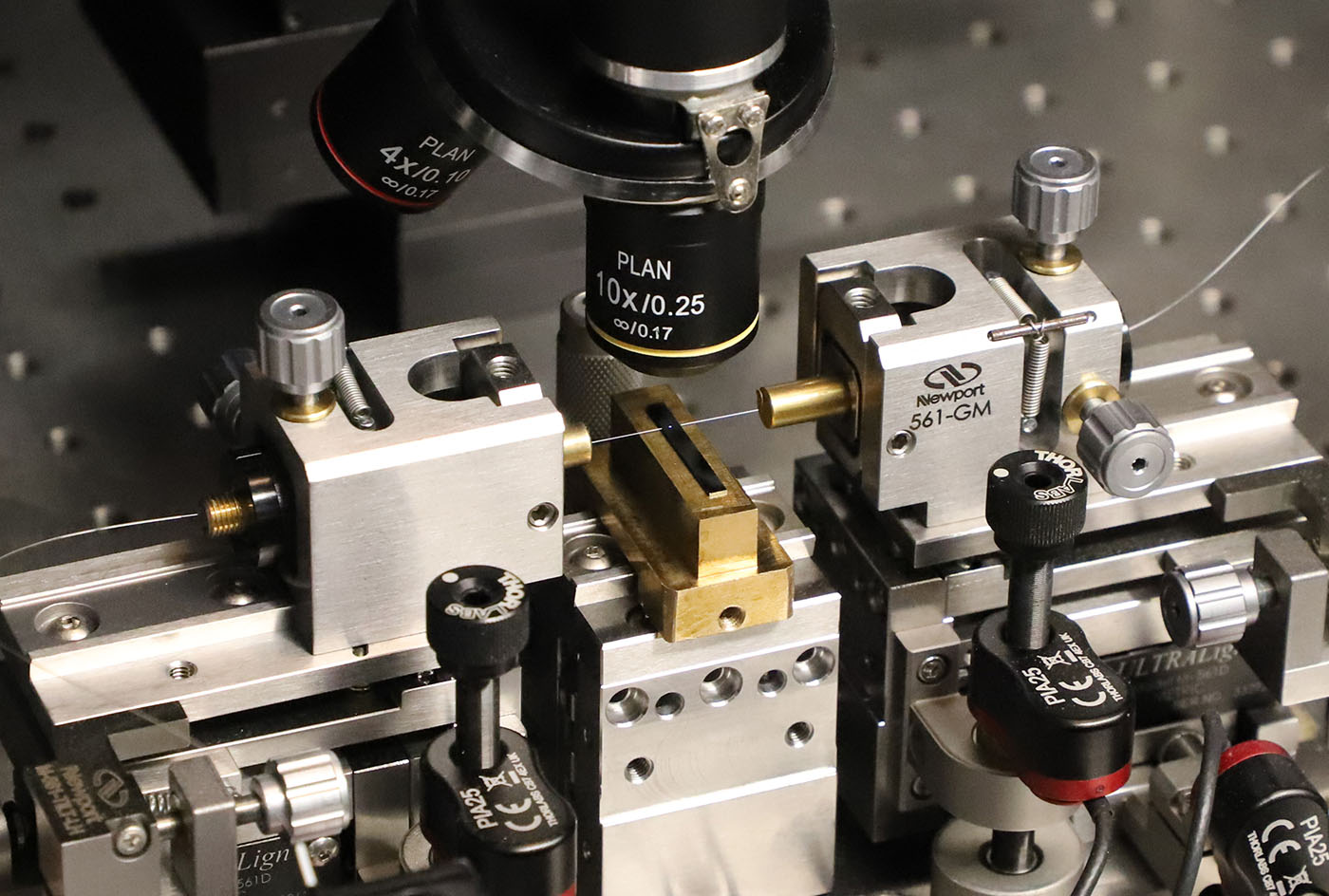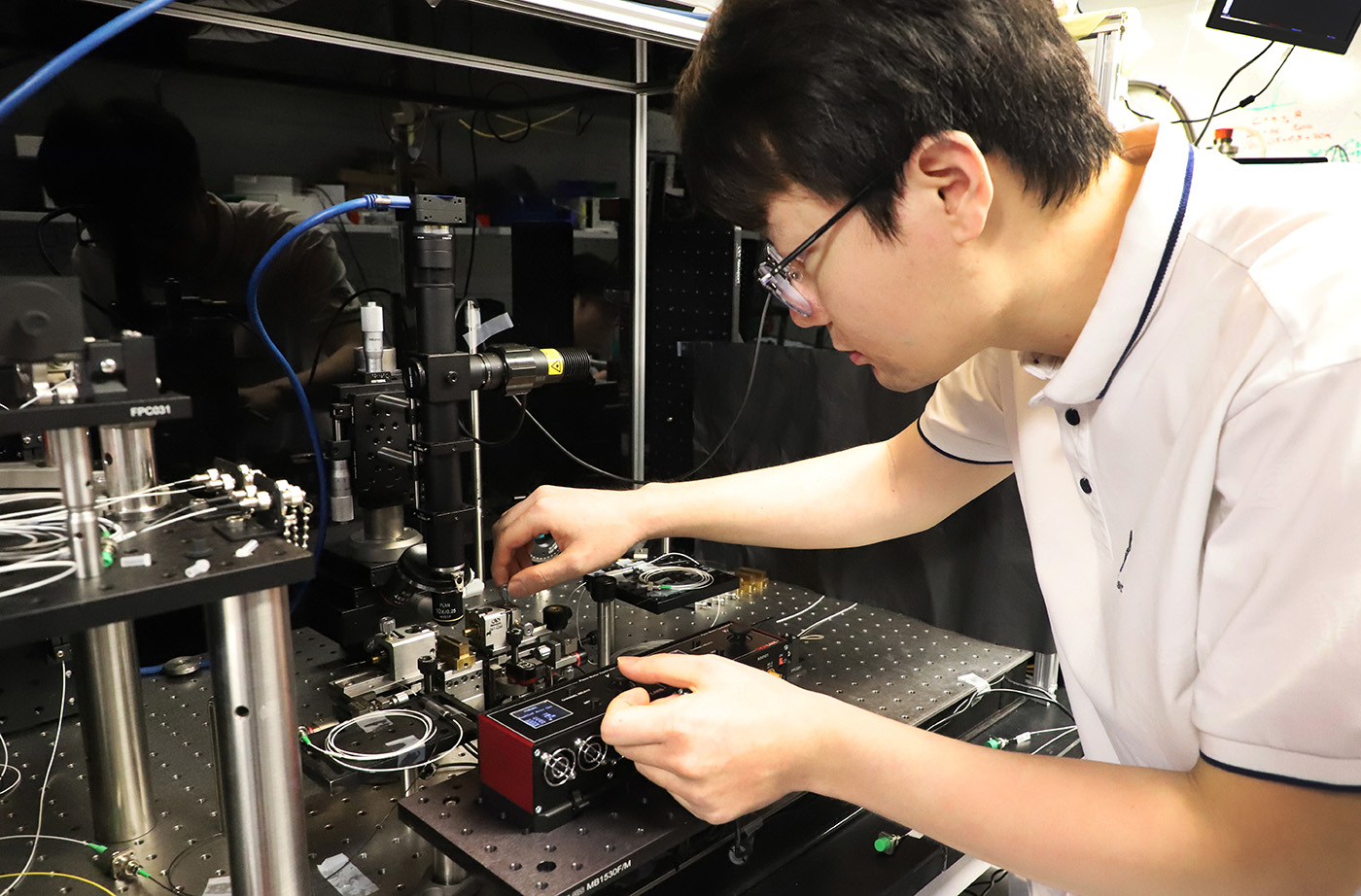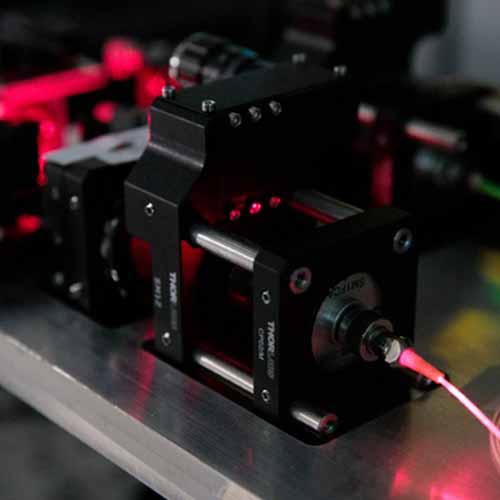Highlights
Improved design better couples light from chip to fibre
 The team’s experimental setup. The extremely thin, almost transparent, fibre connects a laser source to the chip and the chip to a power meter. The researchers demonstrated a method to improve the chip-fibre coupling.
The team’s experimental setup. The extremely thin, almost transparent, fibre connects a laser source to the chip and the chip to a power meter. The researchers demonstrated a method to improve the chip-fibre coupling.
Light can pass from a chip into optical fibre more efficiently, thanks to a novel coupling design from CQT’s Alexander Ling and Du Jinyi and their co-authors in Singapore and the United Arab Emirates. Their work reported in Optics Express on 13 March 2024 could improve the performance of silicon photonic chips in quantum technologies.
Researchers expect such integrated optical systems to be important for quantum communication and computation since photons are a key carrier of quantum information. Silicon is a promising platform because it is scalable and cost-effective.
In measuring photon pair generation, the team found their method was at least two times better at heralding efficiency – collecting both photons from a chip – than previously reported designs.
The researchers have also submitted a patent application for their approach.
Matching modes
Silicon has a high refractive index that makes the mode, or beam size, of light travelling inside it small. This is good for making highly compact circuits and doing nonlinear experiments, but a challenge for routing light into optical fibres for transmission to other components.
In optical fibres, light has a much larger mode size. At a wavelength of 1550 nm, for example, the mode of light in a silicon chip is less than 1 μm in diameter but is 10 μm in standard fibre.
“To collect the light from the chip, the mode size of the chip and fibre should be the same otherwise there would be a huge loss,” says Jinyi, a CQT PhD student and the first author of the paper.
The researchers match the modes with an intermediate step. On the chip, they taper the waveguide that guides the light, narrowing its width towards the chip edge. This widens the mode of light to about 3 μm.
On the fibre, they add a segment of small-core fibre known as UHNA7, purchased off the shelf. This fibre is made of a material with a high refractive index that has a mode size of about 3 μm.
Connections using UHNA7 fibre were tried before, but photons generated in the dopants within the fibre caused problematic noise. The team resolved this issue by reducing the length of the UHNA7 fibre to just 1 cm – long enough to get the coupling benefit while short enough to minimise noise.
The team’s other innovation was in proposing a new method optimising the splicing parameters to connect the UHNA7 fibre to the standard optical fibre. To find optimum parameters, they input a 1550 nm laser to the standard fibre and measured the output power from the UHNA7 fibre, monitoring the loss of laser power continuously during splicing. With their method, a splicing loss below −0.1 dB can be obtained with minimum trials.
“The difference between the input and output power indicates how much loss is in the connection area,” says Jinyi. “Our proposal is a universal way to find the best splicing parameters for any splicer model.”
 CQT PhD student Du Jinyi, pictured at work on the setup, is the paper’s first author. This is also his first publication.
CQT PhD student Du Jinyi, pictured at work on the setup, is the paper’s first author. This is also his first publication.
Coupler advantages
Testing their edge coupler design with 1550 nm light, they observed a low coupling loss of -0.64 dB, comparable to the best works in the field.
Next they tested their coupler with a correlated photon pair source, routing ‘signal’ and ‘idler’ photons generated on the chip to the fibre. The researchers calculate a heralding efficiency by dividing the coincidence count, where both photons are detected, over the total signal or idler photons detected. Their measured heralding efficiency of 21.3%, which takes into account a detector efficiency of 38%, is two to five times higher than state-of-the-art values.
The connections to the chip had the advantage of being stable and repositionable too. The tips of the UHNA7 fibre were simply held against the edge of the chip – an arrangement known as ‘butt coupled’ – with friction enough to maintain alignment. The highly stable coupler allowed them to collect data for 10 days with only ±0.1dB fluctuation. Benefiting from this stability, they observed 0.0004 auto correlation function đť‘”2(0) by conducting measurements for 1 hour. A low auto correlation function value would indicate that the photon pair source has low noise and a low multi photon emission rate. The team’s observed value is 10 times lower than the lowest reported values.
This contrasts with an alternative coupling method using ‘lensed fibres’, where the tip of a standard fibre is pulled such that its mode shrinks to match the chip’s. The sharp, fragile tips are always placed away from the chip and are sensitive to movement. Other methods may use oil or glue to improve the stability of the connections but this makes the fibres irremovable from the chip.
The researchers now plan to see if their technique can be applied to other photonic chip platforms such as silicon nitride, lithium niobite and aluminium nitride.








